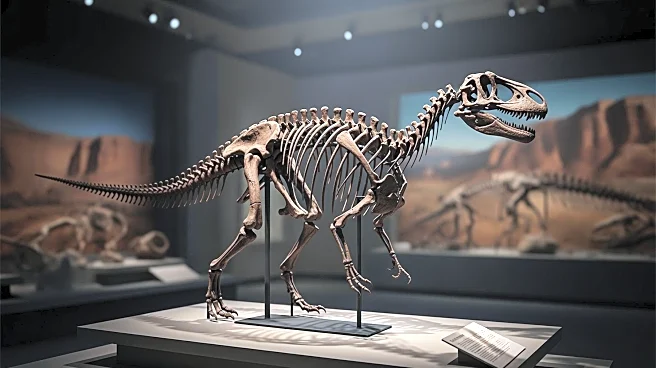What's Happening?
A new dinosaur species, Enigmacursor mollyborthwickae, has been discovered in Colorado and is now on display at the Natural History Museum in London. This fleet-footed dinosaur, measuring about three feet long, is classified among neornithischians, a group
of small, two-legged herbivores. The discovery helps clarify previous taxonomic confusion among small plant-eating dinosaurs from the American West. The specimen, collected on private land between 2021 and 2022, was purchased by the museum and scanned for global research access. The dinosaur's leg proportions suggest it was a quick runner, and its skeleton indicates it was still growing. The discovery provides a stable reference for future comparisons, distinguishing it from similar small dinosaurs.
Why It's Important?
The discovery of Enigmacursor mollyborthwickae is significant as it addresses longstanding taxonomic issues among small herbivorous dinosaurs, which have often been overlooked in favor of larger species. This clarification is crucial for ecological and evolutionary studies, as it provides a more accurate picture of the diversity and roles of small dinosaurs in the Jurassic ecosystem. The digitization of the fossil allows for broader scientific collaboration and research, enhancing the understanding of dinosaur anatomy and evolution. This discovery also highlights the importance of preserving and studying smaller fossils, which can offer insights into the dynamics of ancient ecosystems.
What's Next?
The digitization of Enigmacursor mollyborthwickae's fossil allows researchers worldwide to study its features without risking damage to the original specimen. This accessibility may lead to further discoveries and insights into small dinosaur species and their ecological roles. The museum's efforts to make the fossil available digitally could inspire similar initiatives, promoting collaboration and advancing paleontological research. Future fieldwork and examination of museum collections may uncover more small dinosaur species, contributing to a more comprehensive understanding of the Jurassic ecosystem.
Beyond the Headlines
The discovery of Enigmacursor mollyborthwickae challenges the traditional focus on large dinosaurs and underscores the ecological significance of smaller species. These small herbivores likely played vital roles in grazing, seed dispersal, and serving as prey, shaping food webs alongside larger dinosaurs. The digitization of fossils represents a shift in paleontology, making rare finds accessible to a global audience and fostering collaborative research. This approach may accelerate the identification of new species and verification of existing ones, enriching the scientific narrative of dinosaur evolution.














